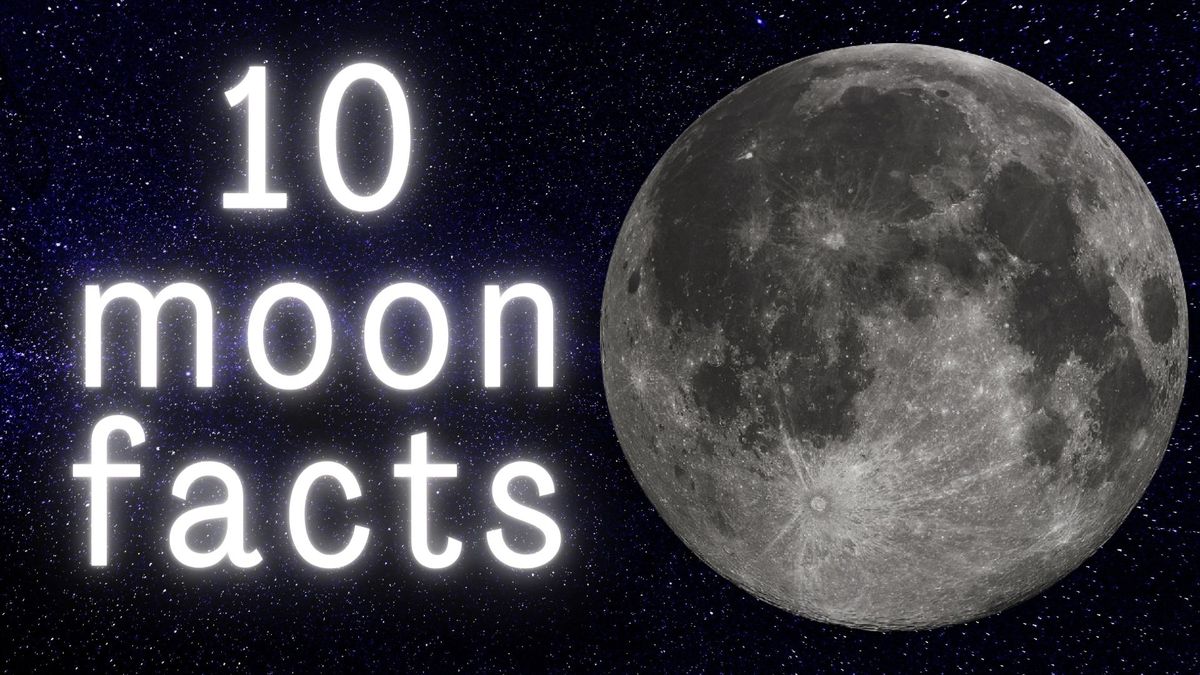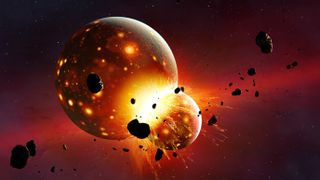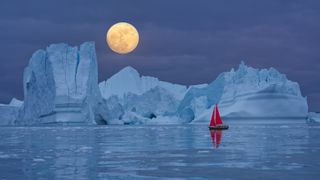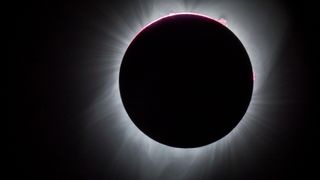10 fascinating facts about the moon
Learn more about our nearest celestial neighbor with these 10 moon facts.

The moon may seem mundane, yet it benefits and influences life on Earth in many ways, from the moonlight it sheds to the tides it creates.
It has also influenced human culture, featuring in mythology and helping humans keep track of time. Humans and many other forms of life depend on the moon, and it is the only celestial body besides Earth we have visited.
Although the moon still holds mysteries, we've learned a lot about our planet's natural satellite. Here are 10 fascinating facts about the moon.
Related: 25 weird and wild solar system facts
1. The moon probably formed in a giant collision

The most widely accepted explanation for how the moon formed is called the giant-impact theory, which proposes that a Mars-size planet collided with the early Earth, forming a cloud of debris that eventually coalesced into the moon. Much of the debris would have come from the colliding planet, but some would have originated from Earth and been ejected into space during the collision, according to the Natural History Museum in London.
Evidence of this impact can be found in the moon samples taken during the Apollo missions, which show that the moon's composition has similarities to and differences from Earth's geological composition.
2. The moon's phases depend on its position
The phases of the moon are determined by where the moon is in relation to Earth and the sun. If Earth is directly between the sun and the moon, the side of the moon facing Earth is fully illuminated and we see a full moon. But if the moon is between Earth and the sun, the illuminated side faces away from us and it is a new moon, meaning we don't see the moon at all.
In between a new moon and a full moon, different portions of the part of the moon the sun illuminates are visible from Earth, creating the moon's phases. When the moon appears to increase in size until it is full, it is said to be waxing; when it is decreasing, it is waning.
3. The "dark" side of the moon is not actually dark
Although we see only one side of the moon, half of it is always illuminated by the sun, and it's not usually just the portion we can see (except during the full moon). Therefore, the "dark" side of the moon is dark only from our perspective on Earth.
Instead, it's more accurate to call it the far side of the moon. Even though we can't see that side from Earth, several missions have photographed and studied the far side of the moon, with the first photos of the lunar far side taken by the Soviet Union's Luna 3 space probe in 1959.
4. The moon produces and changes the tides

You likely know that the moon's gravity is the main cause of the tides on Earth. This gravitational pull causes two bulges in Earth's oceans that represent high tides: one in the part of the ocean on the side closest to the moon, and one on the opposite side. The area of high tide opposite the moon is caused by the moon pulling the planet and not the ocean toward it. Between these two bulges of high tide are areas of low tide.
Though the moon's gravity is the strongest cause of tides on Earth, our planet's rotation and the gravitational force of the sun also contribute. The strength of the tides and the water level have varied widely throughout Earth's history, but this is mostly caused by changes in climate and sea level, the shifting of Earth's continents (plate tectonics) and several other factors.
5. Earth's gravity also affects the moon
Just as the moon's gravity causes the tides, Earth also affects the moon — and not just by keeping it in orbit. We see this effect every night in the familiar "man in the moon." The pattern of markings is always the same because the same side of the moon always faces Earth. This is called tidal locking" and is caused by the gradual impact of Earth's gravity on the moon. Our planet exerts a much stronger pull on the moon than it does on us.
6. The moon is slowly moving away from us
The gravitational impacts that caused the moon to become tidally locked with Earth were complicated, according to NASA, and as they took effect, they released energy. That energy caused the moon to begin slowly drifting away from Earth even as it was still forming. Eventually, the processes of formation and tidal locking stopped changing the moon's orbit around Earth, but the moon is still drifting away from our planet by about 1.5 inches (4 centimeters) per year. While this isn't much, it will cause the moon to become notably more distant from Earth over millions of years.
7. The moon has "moonquakes"
Most of us probably imagine the moon as a cold, dead rock in space, and for the most part, we'd be right. However, it's not entirely stagnant. Just as areas of our planet are rocked by earthquakes, there are "moonquakes" on our satellite, though they are usually weaker and last longer than the ones on Earth. Several factors can cause moonquakes, including impacts from meteors, changes in temperature, Earth's gravity, and structural weaknesses in the moon's interior. Though some of these quakes would barely be noticeable to any future humans on the moon, others could pose significant hazards.
8. Solar eclipses are cosmic coincidences

A solar eclipse happens when the moon is aligned directly between the sun and Earth. During a total solar eclipse, the dark silhouette of the moon appears to block out the sun so precisely that, during the few minutes of totality, the sun's corona, or outer atmosphere, is still visible. There is no reason that this effect should happen with the precision it does, or that the two bodies should appear so close in size. In reality, tens of millions of our moon could fit in the sun if it were hollowed out. Still, when the alignment of the sun, moon and Earth is perfect, people in a few areas can observe the marvel of this cosmic coincidence in our skies.
9. The moon's appearance can be affected by "Earthshine"
On a clear night, you might notice that although only part of the moon is illuminated, you can also see the faint circle of the rest of the moon. This is caused by a phenomenon called Earthshine. Just as moonlight is caused by the moon reflecting light from the sun, Earth also reflects that light. This means that part of Earth would appear bright if you were to stand on the moon, and it also causes Earth to cast some of that light back onto the moon. So, even when no sunlight is cast on a portion of the moon, Earthshine can faintly illuminate its dark regions.
10. The moon has a unique smell
The moon has no substantial atmosphere and, therefore, no air. However, the Apollo 11 astronauts were surprised to discover that the moon has a smell, which clung to their spacesuits, equipment and the lunar samples they collected and was detectable once they were in an environment with air again. Apollo astronauts described the smell as metallic, similar to burnt gunpowder or the smell in the air after a firecracker goes off. The smell was likely caused by a chemical reaction between something in lunar dust and the oxygen in the air. However, lunar samples on Earth do not smell, so it must be due to a temporary reaction.
Join our Space Forums to keep talking space on the latest missions, night sky and more! And if you have a news tip, correction or comment, let us know at: community@space.com.
Get the Space.com Newsletter
Breaking space news, the latest updates on rocket launches, skywatching events and more!

Rebecca Sohn is a freelance science writer. She writes about a variety of science, health and environmental topics, and is particularly interested in how science impacts people's lives. She has been an intern at CalMatters and STAT, as well as a science fellow at Mashable. Rebecca, a native of the Boston area, studied English literature and minored in music at Skidmore College in Upstate New York and later studied science journalism at New York University.


